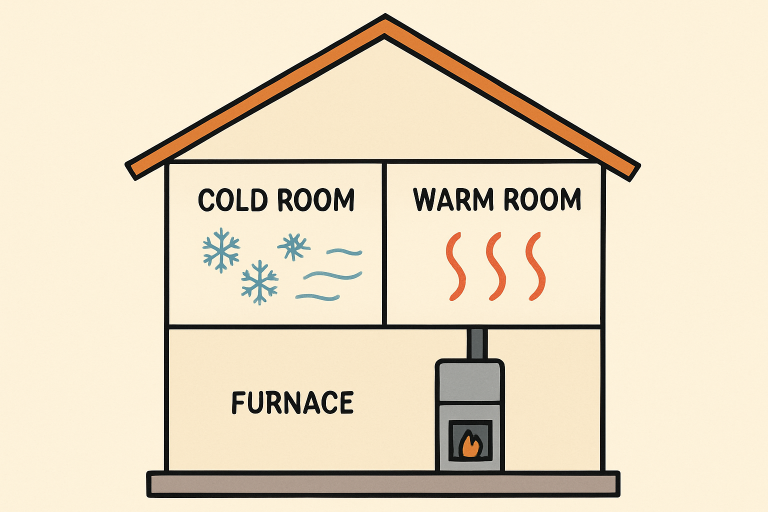
Contents
- Key Takeaways:
- Unsteady Temperatures Throughout Your Home
- Unexplained Spikes in Energy Bills
- Frequent Repairs and Persistent Malfunctions
- Unusual Noises and Persistent Odors
- Visible Signs of Rust or Soot Around Furnace Components
- Decline in Air Quality and Rising Allergy Symptoms
- Outdated Technology and Lack of Modern Safety Features
- What to Do Next: Evaluating Your Replacement Options
Key Takeaways:
- Furnace age isn’t the only sign—declining performance, safety risks, and rising costs can appear much earlier.
- Warning signs include uneven heating, higher energy bills, frequent repairs, strange noises, and unusual odors.
- Rust, soot, poor air quality, or outdated technology may indicate that it is time to replace your furnace.
- Modern systems improve efficiency, safety, and comfort while reducing long-term costs.
- Professional installation ensures proper sizing, performance, and reliable warranties.
Many homeowners instinctively look to the age of their furnace when considering replacement. Still, several other indicators can warn you of declining performance and safety risks long before a breakdown occurs. By understanding these signs, you can protect your comfort, health, and wallet—and ensure your home stays efficiently heated during the coldest months. If you face one or more of the issues below, it may be time to explore furnace installation in Erlanger, KY, with the help of a trusted local professional. Relying solely on your furnace’s age can risk your home’s energy efficiency and safety. Modern systems are designed to regulate temperatures evenly, minimize operating costs, and ensure clean indoor air—all qualities that older or failing furnaces may struggle to provide. Recognizing when your furnace is no longer up to par is key to maintaining a healthy living environment.
Unsteady Temperatures Throughout Your Home
If you consistently notice one room is chilly while another feels overheated, your furnace may struggle to distribute heat evenly throughout your home. Uneven temperatures can be a warning sign of declining furnace performance, indicating weakened blower components, airflow malfunctions, or a system that is no longer properly sized for your house. Persistent unsteady temperatures are more than an inconvenience—they can signal serious system inefficiencies.

Unexplained Spikes in Energy Bills
Despite no significant change in thermostat settings or outside temperatures, a sudden or steady increase in heating bills is a classic sign of furnace inefficiency. Aging or outdated units typically consume far more fuel than modern, energy-efficient models. According to the U.S. Department of Energy, high-efficiency furnaces can save homeowners up to 20% in heating costs compared to older systems.
Frequent Repairs and Persistent Malfunctions
When your furnace requires attention from a technician several times a year, it’s often a signal that the equipment is nearing the end of its useful life. Frequent repairs do more than disrupt your comfort; they can quickly add up, making replacement a smarter financial decision.
Unusual Noises and Persistent Odors
A healthy furnace should operate with minimal noise, aside from the soft hum of air circulating. Banging, screeching, or rattling are warning signs of loose or worn mechanical parts—and ignoring them can lead to costly or dangerous mechanical failures.
Similarly, unusual odors, such as the smell of burning dust or a persistent burning smell, may signal issues with combustion or clogged filters. In addition to reducing air quality, these odors can sometimes pose serious health risks if not quickly addressed.
Visible Signs of Rust or Soot Around Furnace Components
Physical deterioration, like rust or soot buildup around your furnace, goes beyond cosmetic concerns. These visible signs typically suggest problems with combustion, flue ventilation, or compromised airflow—each of which can negatively impact system efficiency or introduce safety hazards into your home.
Decline in Air Quality and Rising Allergy Symptoms
Older furnaces can contribute significantly to poor indoor air quality, especially when filters and ductwork are not regularly maintained. Dust, debris, and even mold spores can be circulated throughout your home, triggering allergy and respiratory symptoms. According to the Environmental Protection Agency, indoor air quality can dramatically impact health, especially for those with asthma or allergies.
Outdated Technology and Lack of Modern Safety Features
Technological furnace design advancements have improved safety, reliability, and efficiency. Features like automatic shut-off controls, enhanced diagnostics, and smart thermostats help prevent dangerous malfunctions and improve home comfort.
If your furnace lacks these upgrades, you could miss out on significant energy savings and peace of mind. When evaluating your unit, check the manufacturer’s details and assess whether it’s compatible with today’s modern controls and safety enhancements.
What to Do Next: Evaluating Your Replacement Options
Once you’ve identified several of the above signs, weighing the costs and benefits of continued repairs versus replacement is important. Calculate your average annual repair bills, energy usage, and potential savings from a more efficient system.
Choosing a professional for your furnace installation is critical. Look for licensed, well-reviewed companies with proven experience. Request written estimates that cover parts, labor, and warranties, and ask about recommendations for properly sizing a system for your specific home needs.
